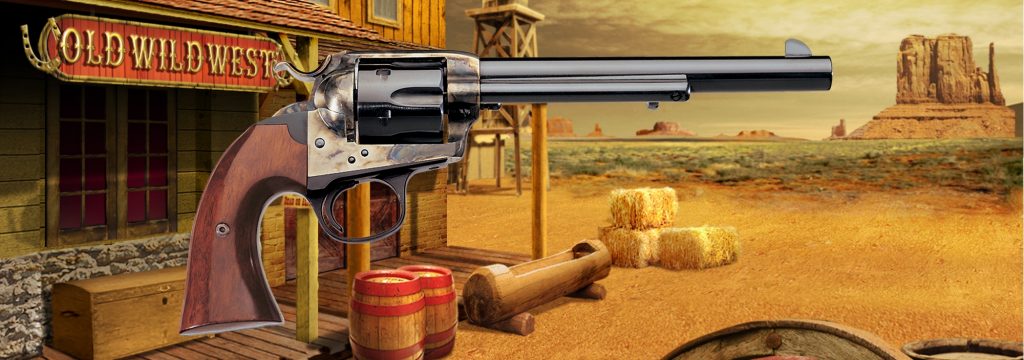
I was startled awake one night by one of our kittens jumping on me on his way to wherever kittens go in the middle of the night. Sometimes when I am startled awake, I can quickly go back to sleep, but not on this night. Sometimes my brain just kicks in and thoughts begin pouring forth. Normally, I just put them to rest, but not this one. Why I started thinking about the Colt Bisley revolver at 3 a.m. is beyond me, but there it was, and I had to do something about them, if only to write the title for this article, satisfy my thinking a bit, and then go back to sleep.
I will never be able to afford an original Colt Bisley revolver, but a Uberti reproduction of the famous pistol that was manufactured from 1894 until 1912 was a possibility. The one I have is manufactured by A. Uberti, Srl. and imported by Cimarron Firearms. I had, at one point, decided that I wanted a collection of Old West and Civil War revolvers, and I have written some reviews on firearms that I had selected. My one qualification, to keep myself from going completely batty with reproduction revolvers, was that there had to be some historical significance with each firearm in the collection. That meant that revolvers like the “Man with No Name” and “Evil Roy” would not be part of the collection. Any early Colt and Remington black powder revolvers were fair game, but cartridge revolvers were another matter.
With black powder from .36 caliber to .44 caliber to black powder cartridge conversion revolvers, to cartridge single-action revolvers I started my collection. Obviously, some revolvers in the collection are not in the original calibers; for example, an 1851 .36 caliber Uberti Colt Navy conversion is now a .38 Special in a modern loading, as ammunition no longer exists or cannot be duplicated. I had to opt for a common caliber among most and the .45 Colt is my common chambering for most reproduction “Army” revolvers, while .38 Special is the chosen caliber for “Navy” versions.
The Colt Bisley reproduction revolver was placed on my ‘must have’ list ever since the first time that I held one in a local gun shop several years ago. I just could not afford it at the time. While not expensive, other firearm priorities replaced my need for the Bisley. Now; however, I can talk about it.
While I have a few gripes about the Uberti reproduction Bisley, the pluses overcome the minuses. The Uberti Bisley revolver is as true to the original Bisley revolver as it can be; it is a faithful reproduction. Cimarron Firearms; however, added a “Cimarron” medallion to the grip that, obviously, is not on an ‘original’ Bisley. But, the ‘spirit’ of the original Bisley is evident in the design and feel of this reproduction in the hand. So, let’s address the ‘spirit’ shall we?
Colt’s Manufacturing Company, LLC (CMC, formerly Colt’s Patent Firearms Manufacturing Company) was founded in 1855 by Samuel Colt, but earlier firearms-making efforts started in 1836 beginning with the Colt Paterson. In or around 1851, Samuel Colt showed his wares in England and Colt opened his London plant on the River Thames at Pimlico and began production on January 1, 1853. The English were enamored by the Colt revolver product because ten guns could be disassembled, and ten guns could be reassembled using distinct parts from different guns. This is to say that England was no stranger to Colt and Colt was destined to be part of the English countryside and gentry.
In 1890, the National Shooting Centre in Surrey England became the location for the NRA Imperial Meeting (the Association’s National Championship), which moved there from Wimbledon. The competition was hosted on the ranges at Bisley Camp having outgrown the Wimbledon Common ranges which had previously been used.
In 1894 Colt, the US firearms manufacturer, introduced and sold the Bisley Model of its famous Single Action Army revolver specifically designed for target shooting. This revolver featured a longer grip, a wider hammer spur, wider triggers, and adjustable sights. More than 40,000 Colt Bisleys were made between 1894 and 1915. It was offered in a variety of calibers including, but not limited to; .32–20, .38–40, .45 Colt, .44-40. My reproduction is chambered in .45 Colt sans adjustable rear sight.
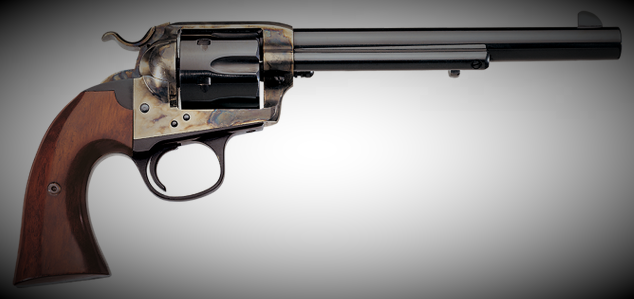
My version has the 7.5-inch barrel, which was the standard at the time for a “Cavalry” revolver and a competition revolver. The frame is color-case hardened, the hammer spur is low and wide, the trigger is wide and curved, and the grip is a perfect reproduction of the original Bisley grip angle. The two-piece grip panels are Walnut and finished in the usual Uberti red and finished in a high-gloss clear.
Some folks asked me why I did not just go for the Ruger Bisley single-action revolver. I usually answer because the Ruger Bisley is a Ruger interpretation of the Bisley and Elmer Keith’s No. 5 revolver and is not true to the Bisley revolver itself; whereas, the Uberti reproduction is a close to the original as one can get.
The grip angle is, indeed, different. The grip angle of the 1873 Colt Single-Action Army revolver is swept downward and back, which allows the revolver to rotate in the hand under recoil, which places the hammer near the thumb of the shooting hand for quick cocking of the action. The Bisley grip; however, is downward and in toward the revolver. The gripping of the Bisley is straighter up and down and the longer butt was intended to force the hand higher on the grip and mitigate the upward rotation of the revolver during recoil. Moreover, the lowered hammer spur is well within reach of the thumb even when the revolver is not in recoil.
The front sight is a tall blade and the rear sight is a notch in the top strap of the receiver. Target models had an adjustable rear sight and replaceable blades for the front sight. While the version that I have is not a target model, it is reminiscent of that revolver that would have been found in the sashes, holsters, and waistband of honest and dishonest men alike of the time. Lawmen and outlaws liked the grip of the Bisley. The Bisley became as popular as the Single Action Army, if not more so, in the hands of shooters who realized that the gun’s distinctive features made it a natural for speed shooting.
The original Bisley had the specification shown below:
- Range: 50 yards
- Weight: 1 lbs, 13 oz
- Length: 11 inches
- Cartridge: .44-40WCF (The .44-40 Winchester Center Fire rounds could be used for both the Bisley and a Winchester Rifle.)
- Action: Single-action revolver
- Feed System: 6-shot cylinder
The Bisley disassembles and assembles like any other Colt SAA. The hammer is brought to the half-cock position, the loading gate is opened, the cylinder rod release button is pushed, the cylinder rod is removed, and the cylinder is rotated outward from the revolver.
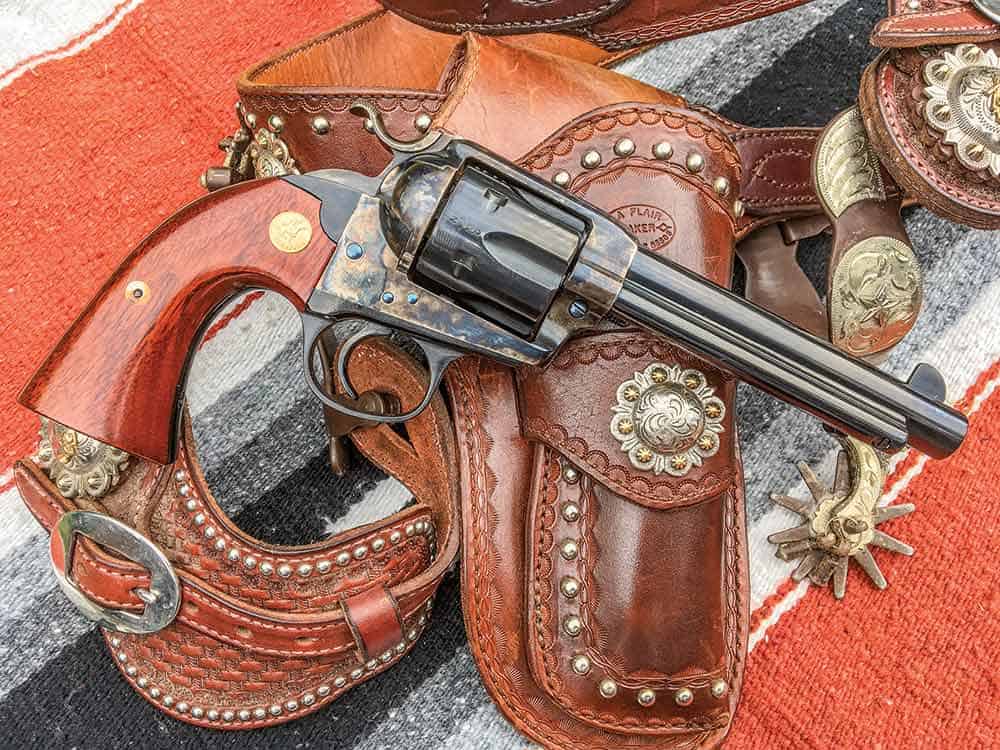
The fit and finish on this Uberti Bisley reproduction is excellent. The timing was correct, but the revolver needed some proper lubricant before it was range ready.
Range Work
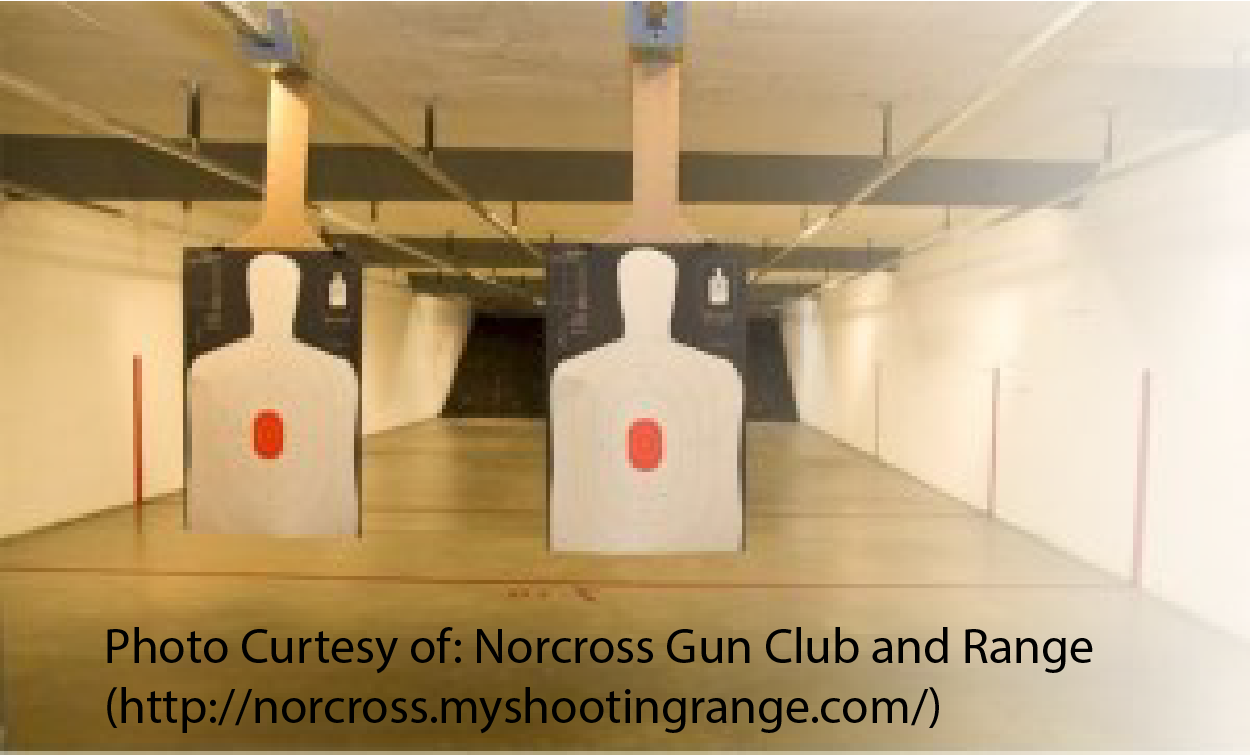
Sometimes, it is a blessed relief to take a break from firing large-capacity semi-automatic pistols.
Range day with a single-action revolver is not one that you hurry. This is the time to slow down and do what was needed to shoot these revolvers in the days of yore, which will provide an appreciation for modern shooting. Shooting a single-action revolver should be a halcyon experience and not a stress-inducing experience of throwing as many bullets downrange in the shortest time. With that said, I am sure that even in the “Old West” there were times for the latter. But this is the here and now and I will, by God, have a pleasurable experience!!
As with any of these early types of revolvers, safety is first. That means that only five is loaded and the revolver is carried on an empty cylinder. The Bisley was no different, and the Uberti reproduction of this revolver is no different.
Unfortunately, I do not get to shoot my single-action revolvers as much as I would like, as I am usually evaluating a more modern firearm or practicing with my EDC. My range days are usually restricted to weekends, and Sunday is my usual B&S (breakfast and shooting) day. But this day, and after the Uberti Bisley was properly prepared, it was time to send some lead through it downrange. The lead is provided by Georgia Arms; a cowboy load of .45 Long Colt 250-grain Round Nose Flat Point bullets traveling at 725 fps.
This day I was especially interested in what shooting stance would offer the best results with the Bisley; shootist or duelist.
Unlike the common straight-arm shooting styles, the recommended Bisley-style was to aim with the wrist and elbow bent.
According to Hugh B.C. Pollard’s, “The Book of the Pistol and Revolver,” the Bisley matches were a timed event with targets staged at 20 yards, then moved to 50 yards as contestants were thinned from the ranks. The contestant could use only one hand with no additional support from their body.
The targets themselves were timed and only visible during a three-second window. During those three seconds, the shooter had to raise the pistol from the shooting rail, aim and fire before the target disappeared again for three seconds. Only one shot was allowed during each appearance of the target and when the target disappeared, the pistol had to be lowered so it was touching a shooting rail. The recommendation was to practice the timing with a metronome.
Each match consisted of 12 shots. At 20 yards the shooter was given 60 seconds to fire six shots. At 50 yards the shooter was given 90 seconds.
This day was to simply check for function and to see what kind of accuracy I could pull off with this first handling of the revolver. A silhouette target at 10 yards would work for function and would tell me what I needed to know about my capabilities with the Bisley.
The Bisley, as expected, performed without flaw and the sights were as close to POI as they could be. Firing from a “Duelist” position garnered the best performance, as best as I could hold the Bisley, which is shaky at best. The trigger is one of the best I have pulled. The hammer, being in close proximity with the cocking thumb, ensured positive and quick cocking of the revolver. Once I had the Bisley dialed in I was gaining more confidence with it, and it is one fine shooting replica.
Carrying the Bisley
In the days of the “Old West” the Bisley revolver would have been carried in a myriad of ways. In today’s time, not so much. In fact, you might only find the Bisley carried during SASS matches and the like. Old timers said that there were two models of Colts, the Bisley and the Frontier. The Bisley was designed for “duelist” or one-handed shooting but using the “shootist” or two-handed style of shooting was also used. Unlike the common straight-arm shooting styles, the recommended Bisley-style was to aim with the wrist and elbow bent. However, I am sure that some shootist, like Pancho Villa (shown below) who seemed to like the Bisley revolver, was not as discerning about shooting style.
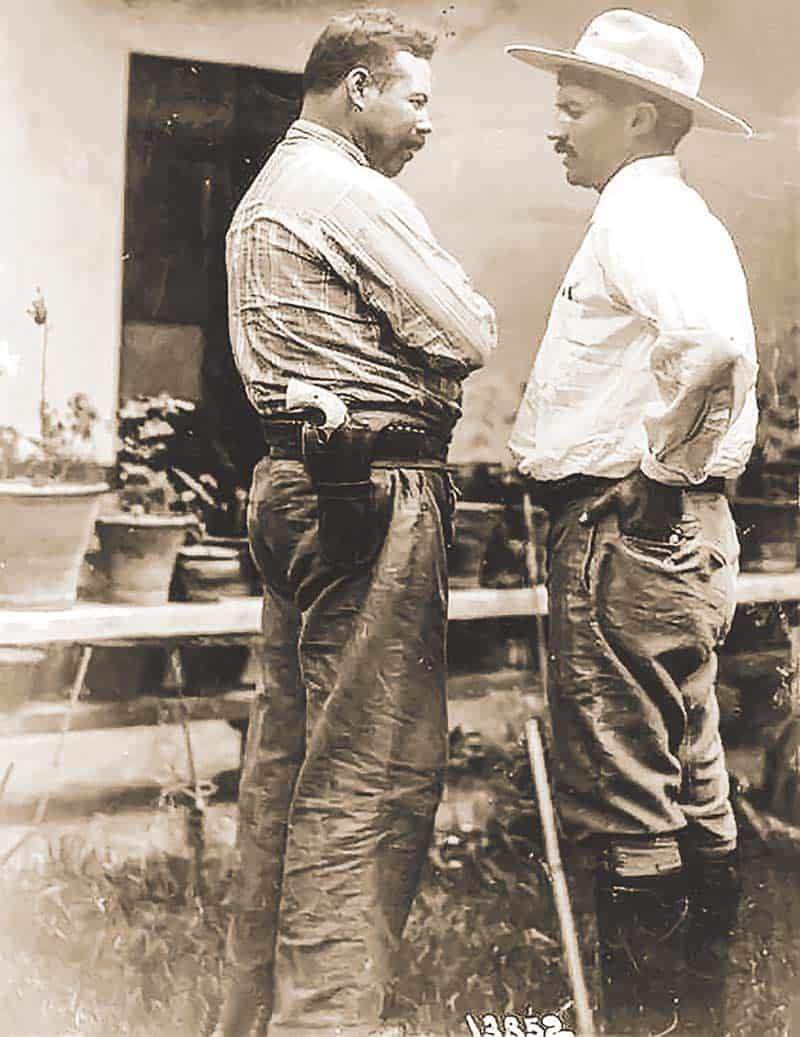
Poncho Villa (Left) with a Colt Bisley
There are some “Old West” revolvers that just begged to be carried cross-draw, and the Bisley is one of those revolvers, at least for me. Something like the cross-draw rig below might just do it for me.
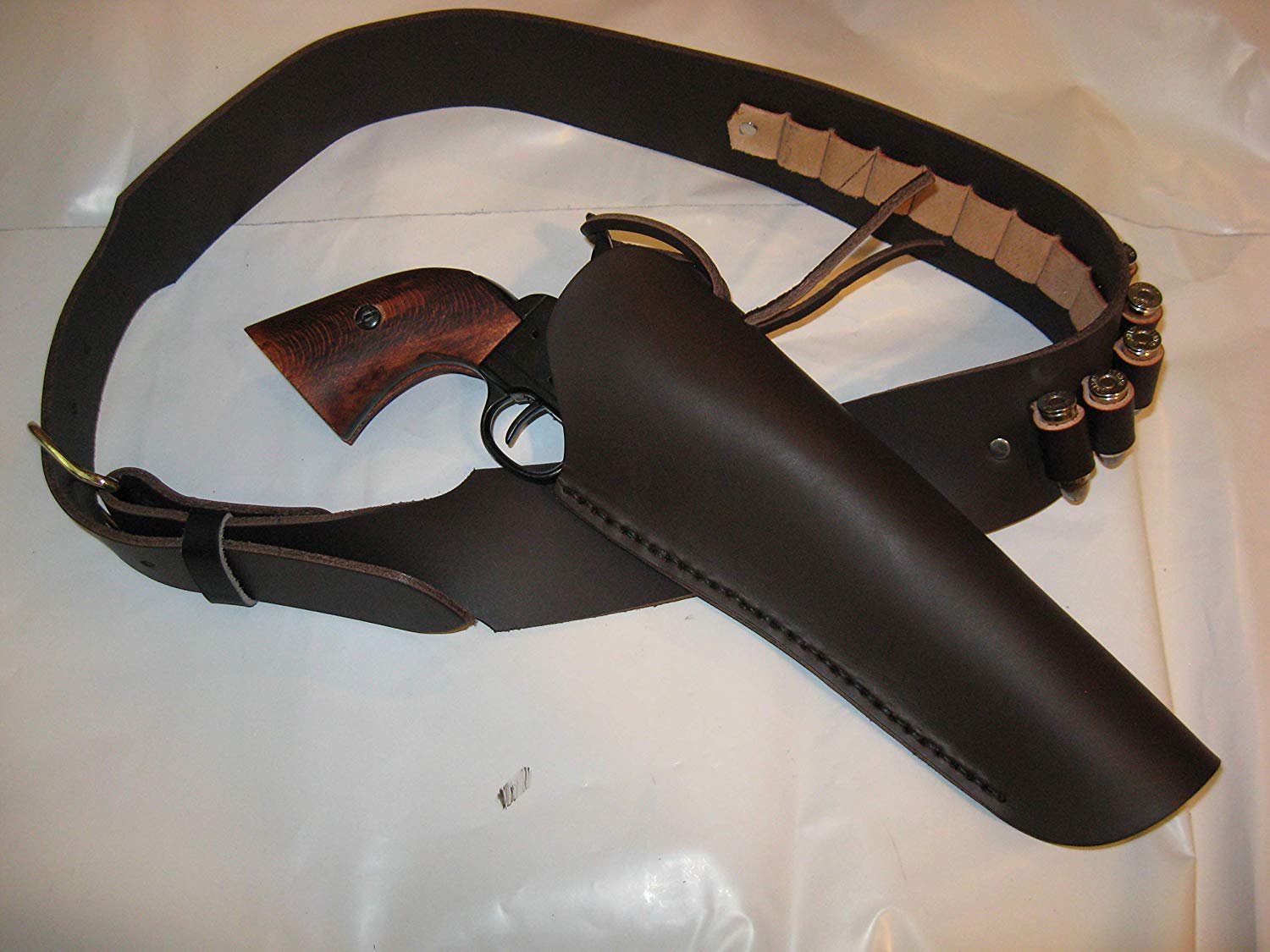
Summary
While it all started for purposes of competition, revolver shooters took quickly to the Bisley and used it for about everything. A decade into the 20th Century, Colt was not selling many single-actions of any kind. Then, in 1915, Colt sold the last Bisley.
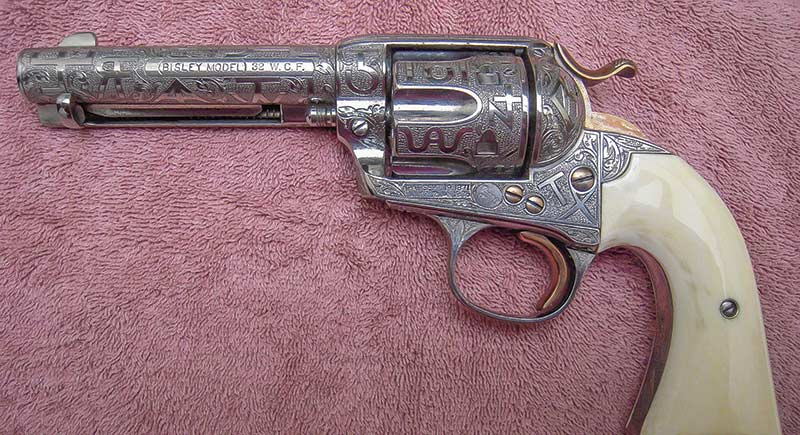
This 1901-vintage .32 WCF Colt Bisley above made the perfect canvas for engraving historic Texas cattle brands – King Ranch, Diamond H, Rocking R, XIT Ranch and others. Photo: Terry L. St. Clair
While I cannot afford an original Colt Bisley revolver, and although I lack the aristocratic blue blood of a high society well-to-do, I am the proud owner of this Uberti reproduction of an American classic revolver that has its heritage in both Americana and in England’s Victorian era.

Uberti can keep bringing us these timeless classic revolvers, in my opinion. Although manufacturers like Ruger bring us modern-day “reasonable facsimiles” of revolver like the Ruger Bisley shown below, a more “near perfect” replica is more likely to help us hearken back to times more when these six-shooters were in their heyday.
Whenever I need to slow down my life a bit, a range day with a good single-action revolver of cartridge or percussion type, or a single-shot black powder percussion pistol or rifle, is a welcome relief for me.
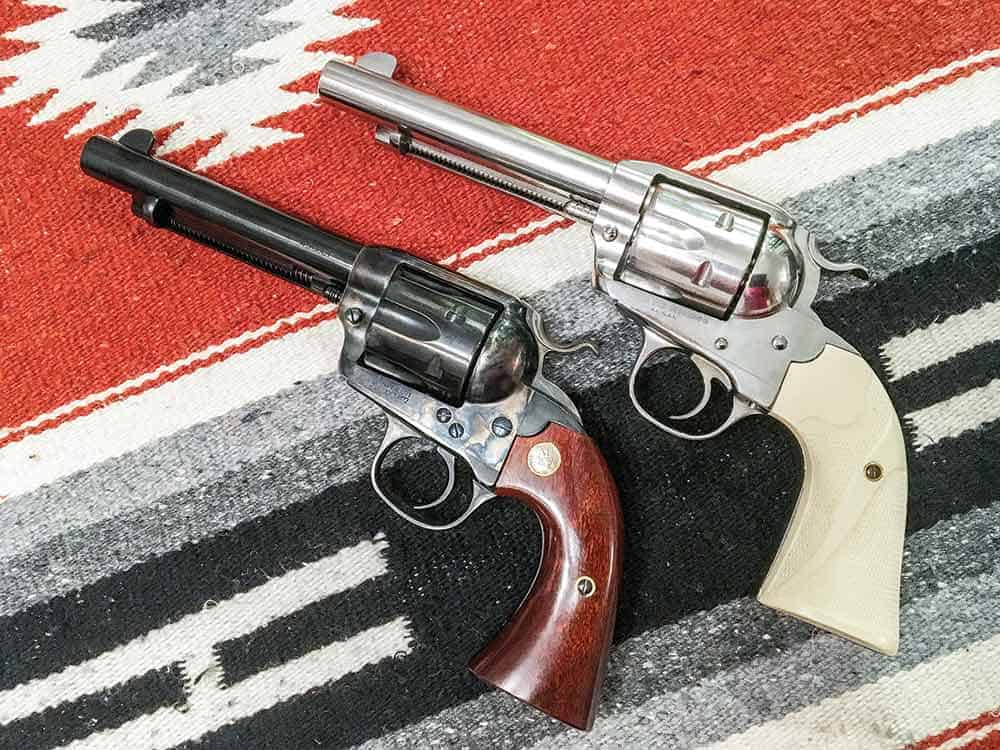
Resources
Uberti Bisley Revolver: https://www.uberti-usa.com/bisley-revolver
![]()

